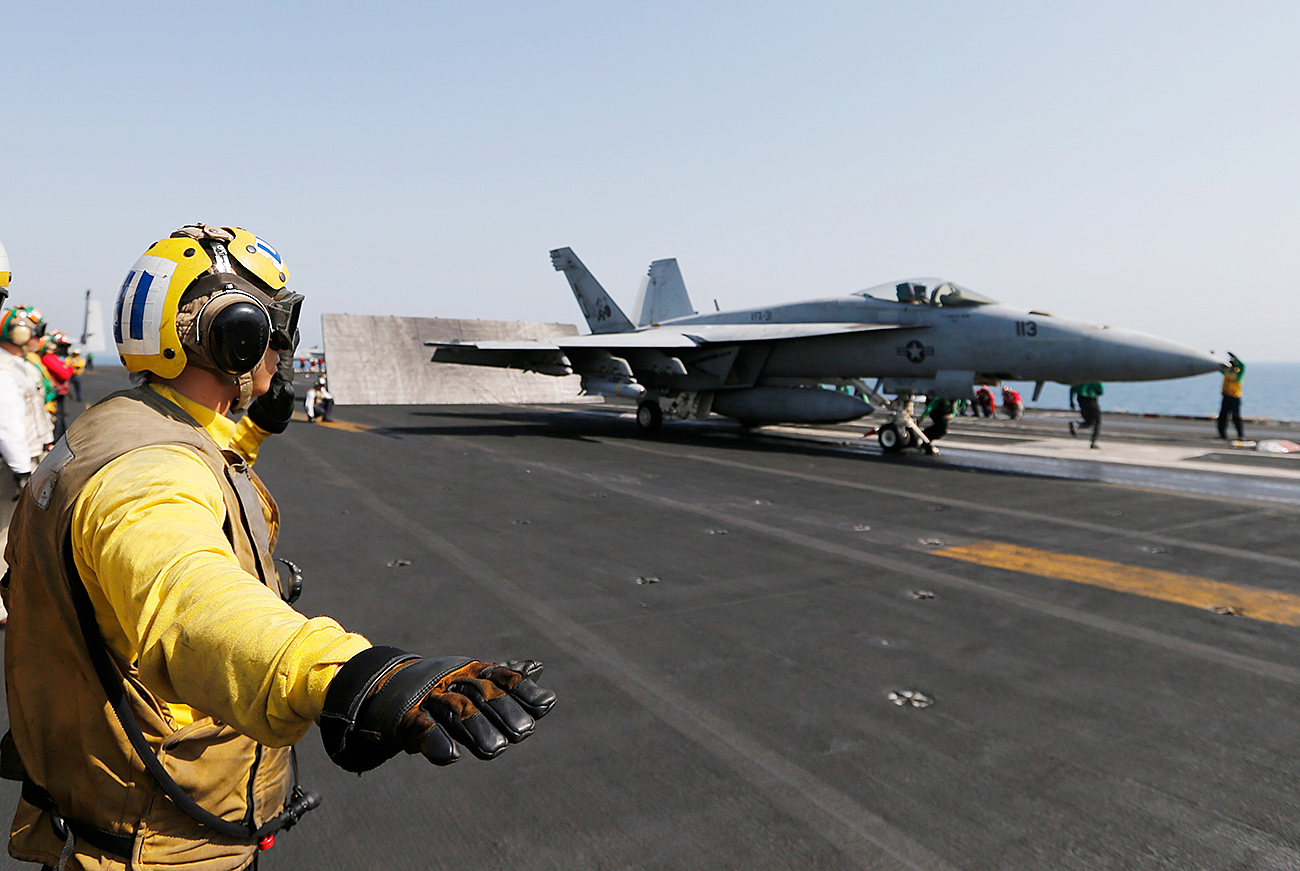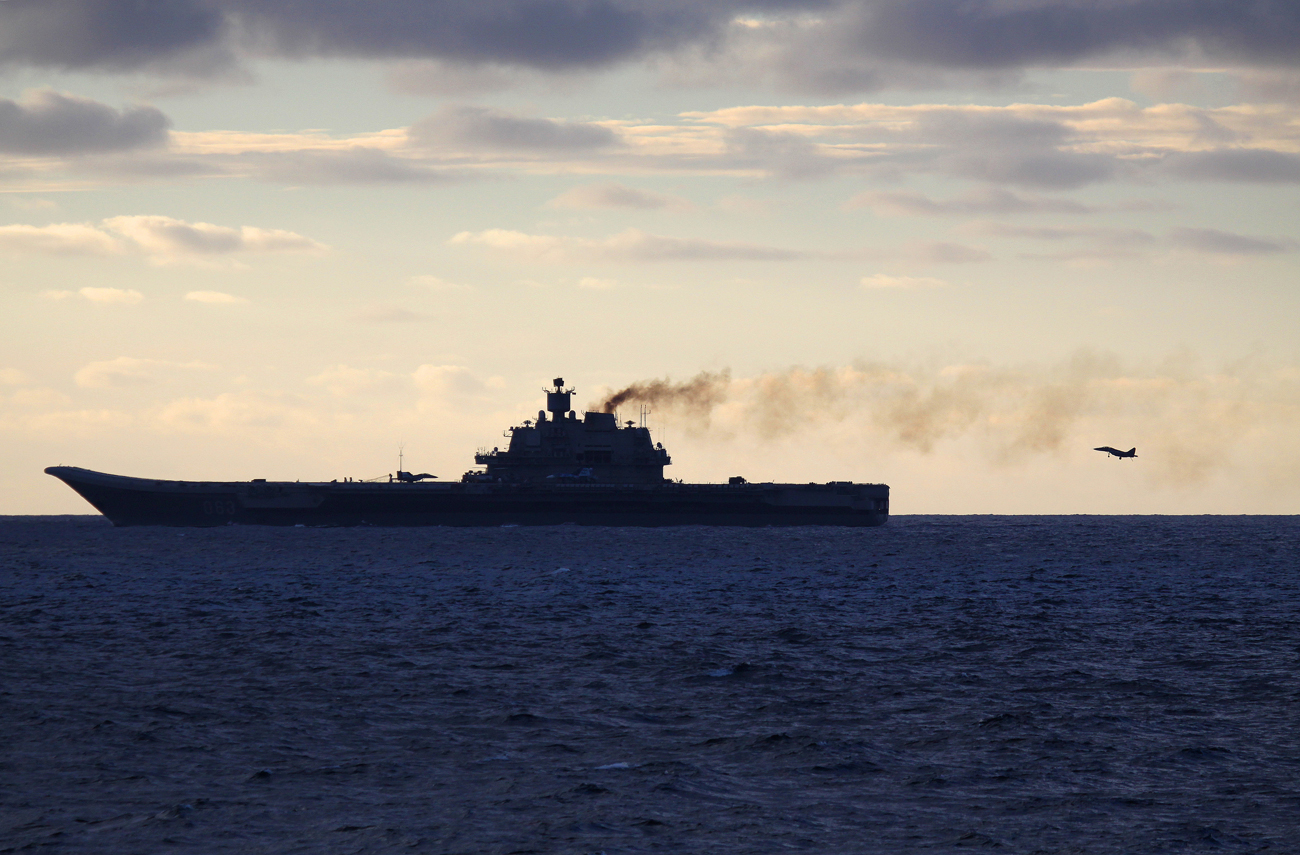
Flight deck crew member confirms the deck is all clear before a F/A-18C Hornet of Strike Fighter Squadron (VFA-87) take offs the aircraft carrier USS George H.W. Bush.
ReutersWarplanes from the USS George H.W. Bush in the eastern Mediterranean are pounding Islamic State targets, said a report on the U.S. Navy's website.
"By defeating violent extremists in Iraq and Syria, we are simultaneously supporting two separate geographic combatant commands," said Vice Admiral Christopher W. Grady, commander of the U.S. 6th Fleet. "We remain committed to defeating Daesh, committed to our allies and partners, and committed to global security."
Named in honor of the 41st American president, the USS George H.W. Bush is the 10th and final Nimitz-class aircraft carrier. Its air wing consists of more than 60 aircraft, including fighter planes, electronic warfare and long-range radar spotting aircraft, and military transport planes and helicopters.
The Carrier Strike Group 2 also includes the guided-missile cruisers USS Philippine Sea and USS Hue City, and the guided-missile destroyers USS Laboon and USS Truxtun.
The USS George H.W. Bush carrier group is expected to soon head to the Persian Gulf, from where its aviation will continue to bomb ISIS targets in Iraq and Syria.
The strikes by the USS George H.W. Bush's warplanes against terrorist targets is a form of competition with the Russian Navy, said Admiral Viktor Kravchenko, former head of the Russian Navy's Main Headquarters.
"The Americans have quite a few land air bases in the region - in Kuwait, Turkey, Qatar, Bahrain and Saudi Arabia - but they decided to boost their operations against ISIS and other terrorist groups by using carrier-based aircraft," said Kravchenko.
The new U.S. president has promised to step up the fight against ISIS, so the U.S. Navy’s assault is not unexpected.
"I think there is cooperation between Russian forces in Syria and the Americans," said Kravchenko. "They must be agreeing on targets and flight routes taken by carrier-based aircraft, particularly through areas that are within striking distance of our long-range anti-aircraft systems."
The U.S. Navy is taking a page out of Russia's book, said Rear Admiral Arkady Syroyezhko, ex-desk officer at the General Staff's main operational directorate.
"These airstrikes by the U.S. Navy's carrier group should be viewed as a transition from talking and waiting to real action," said Admiral Syroyezhko. "The most important thing is that they should not mistakenly bomb troops and forces that are allied to us. Thus, matters that concern approving targets and actual targeting are paramount. Finally, the bigger the strikes against the terrorists, the sooner there will be a peaceful settlement in the region."
The Admiral Kuznetsov returned to its base in Severomorsk in early February. The aircraft carrier's commander, Sergei Artamonov, said that the carrier group was shadowed on its voyage from Severomorsk to the Mediterranean by up to 60 NATO ships.
"In certain places, for instance from the Norwegian Sea to the eastern Mediterranean, our group was simultaneously escorted by 10 NATO ships," said Artamonov.
 Russian aircraft carrier Admiral Kuznetsov. / Photo: AFP / East News
Russian aircraft carrier Admiral Kuznetsov. / Photo: AFP / East News
In November 2016 the Defense Ministry announced the first combat use of carrier-based aviation in Russian history. During the expedition, the Admiral Kuznetsov lost two fighter planes in the Mediterranean - a MiG-29 and a Su-33. The accidents happened on landing because of technical problems with arresting gear.
First published in Russian by Gazeta.ru.
If using any of Russia Beyond's content, partly or in full, always provide an active hyperlink to the original material.
Subscribe
to our newsletter!
Get the week's best stories straight to your inbox